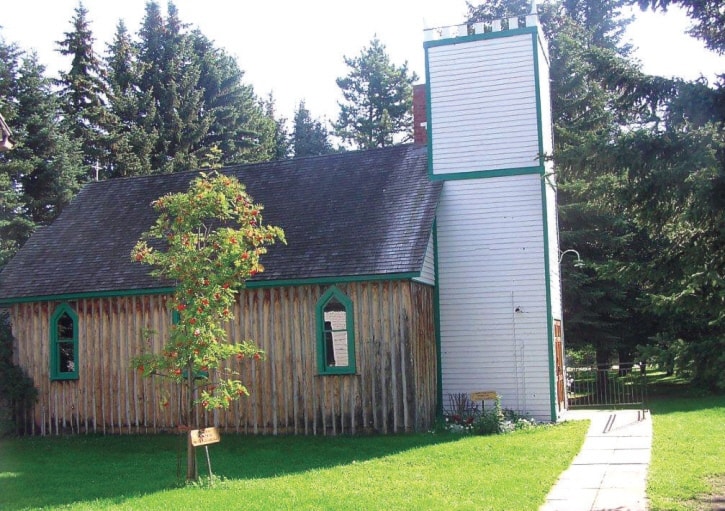The lush and fertile rolling land to the west of Ponoka and bordering on the pristine Blindman River Valley and the shores of Gull Lake began to develop at a rapid pace at the end of the 19th century. Kansas Ridge, NWT would be the first name given to this community, as many of the settler families had made the long trek from the Kansas area with their families and a few precious belongings. Among that founding group were the three Rimbey brothers, Sam, Ben, and Jim, after whom the new village would be officially named in 1904, and when Ben Rimbey registered 3-quarters of land for his family in 1899, the first chapter of the exciting story of Rimbey, Alberta had begun in all its glory.
As the vibrant little village began to gather a lot of interest from near and far, a promotional brochure would declare Rimbey to ‘have every prospect of becoming a good town.’ By that time, it already had two stores, a large hotel, a grist mill, a saw mill, a creamery, school, Methodist Church and Church of England. The Village of Rimbey grew along a dirt street faced with wood frame buildings with boom fronts that would distinguish them from the many homes that were also being built around the community. In 1919, the railway reached Rimbey and there was a great deal of excitement and enthusiasm for the ‘thriving new town by the tracks.’ which is now Highway 20. Two grain companies built elevators along the tracks the following year and Rimbey’s population would swell to 319 by 1921, the lumber yards were busy with the building boom, and the popular village welcomed many new families. Along the way in those busy days, the Village of Rimbey thrived, but many times had to bounce back from frequent fires that destroyed some businesses on Jasper Avenue, now 50 Avenue.
The steadily growing list of enthusiastic merchants who took up residence were selling everything from farm implements to photographic supplies, and with arrival of the automobile, many service stations would be established. In 1930, the village acquired their first hospital, which gave a very welcome boost to the size of the community workforce. One of the first real setbacks and abrupt changes for the Village of Rimbey was the arrival of the Second World War, which resulted in many young men and women and sometimes their families leaving the area. When the war was over only some of them returned, but many new families and had also chosen Rimbey as their new home, with the population surging to 634 by 1946, and the ongoing success resulting in Rimbey officially becoming a town on January 1, 1949 with a population of 757 and Benjamin Gunn as the first mayor.
As a result of the town status, the empty lots north of Jasper Avenue were soon filled with houses, and improvements were made to the streets and sidewalks. Development, however, became haphazard, as Rimbey continued to mix business and industrial sites with residential lots. A much needed Planning Report in 1954 would determine that zoning should be brought in as well as some public space be established to create a more attractive town as well as ongoing improvements being made to the commercial area to better service a population that had now reached 915, as well as a thriving rural area. Modernization through the 1960s began to change the appearance of Rimbey’s historical 50 Avenue, but if you stroll around the friendly community of over 2500 residents today, you will see that many of the colorful and vital remnants of the past have been proudly preserved for future generations and visitors to appreciate and enjoy. Following are some of the many milestones from over 113 exciting years of steady growth and outstanding successes of a little village that grew into the vibrant and friendly Town of Rimbey.
1901 was a banner year for the Village as the Brothers Rimbey moved into their new homes, and Charles Townsend opened the first store in one of those dwellings.
1902 the Dominion Land Survey established the new town site that would later become Rimbey, while Jim Cox opened the first general store, stocked it with 12 wagon loads of stock from Lacombe, and over the years would become a community institution.
1905 to 1908...After Alberta officially became a province on September 1, 1905, Rimbey continued to expand with the Anglican log church built in 1907, the Methodist (United) Church in 1908, and the first Blacksmith shop on main street in 1908.
1914-1932...featured an amazing span of progress for the Village of Rimbey, including the arrival of the first physician, Dr. Samuel Davies from Nebraska in 1914, and then when the railway arrived the following year, new businesses that prospered included the Empress Theatre and Fred Newsom’s popular Barber Shop. Other milestones saw the first community high school started by Mabel Fleming Mellis to save having to send the older children to Lacombe after completing Elementary School. Jack Beatty opened his first hardware store in 1920 then later built his home on the crossroads of Main Street which is now an historical site, Rimbey was so happy to receive electricity in 1925, and the new St. Paul Hospital opened in 1932.
In 1951 water and sewage was installed; 1953 welcomed the town’s first Library with a $50 budget for books; In 1960 Fred Schutz’s legendary column in the Rimbey Record called for the establishment of a local museum, which soon became an ongoing reality and legacy when Lt. Governor Grant MacEwan officially opened Pas-Ka-Po History Park during our Alberta Centennial in 1967, and now hosts many gala annual celebrations and family orientated activities. In 2002 Rimbey proudly hosted their 100th anniversary celebration from July 18 to 21, as well as Alberta’s 100th birthday from September 1 to 4 in 2005, and the 100th anniversary of the International Truck from July 13 to 15, 2007.
